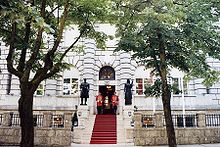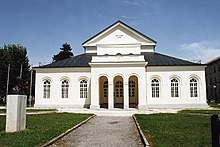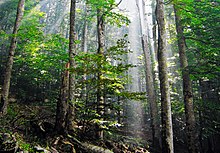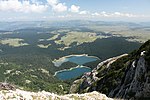Tourism in Montenegro



























Montenegro is a small Mediterranean country with rich architectural and cultural heritage, diversity of landscapes and climates, and well preserved natural environment. Naturally well-suited for development of all kinds of tourism, Montenegro is focused on becoming an elite tourist destination. Montenegro is considered one of the fastest-growing tourist destinations. In 2007, over a million tourists visited Montenegro, making some 7.3 million overnight stays (23% increase, compared to 2006). This accounted for some 480 million euros in tourism revenue in 2007 (39% increase, compared to previous year).[citation needed] In 2014 tourism realised 1.5 million arrivals.
Advantages and disadvantages
Almost all economic activities in Montenegro are directed towards facilitating the development of tourism. The Government aims to attract greenfield investments, which should make best use of undeveloped parts of the coast, such as Jaz Beach, Velika Plaža, Ada Bojana and Buljarica. Such investments could potentially reshape the appeal of Montenegro to tourists, making it a highly competitive destination for sustainable quality tourism.
Montenegro can be presented as a destination offering a variety of attractions and all-year tourism is possible by publicising its varied features. Therefore, the Tourism Masterplan of Montenegro is also paving the way for a national development program for nature based tourism, especially hiking and biking, with new infrastructure and services. The realisation of a 3-year-program was started in 2007.
The biggest problem of Montenegrin tourism is inadequate infrastructure, most notably the obsolete road network and difficulties with water and electricity supply in the coastal area. For that reason, a main investment of the government is building new roads and reconstruction of the current road infrastructure.[citation needed]
Main points of interest
North Coast region
This notable coastal region is of primary interest to tourists in Montenegro. The Montenegrin Adriatic coast is 295 km long, with 72 km of beaches, and with many well-preserved ancient old towns. The main attractions along the north coast are:
- The old Town of Herceg Novi
- The old town of Kotor, listed with UNESCO world heritage sites
- Boka Kotorska (Bay of Kotor), with the ancient small town of Perast
- Porto Montenegro - Luxury Yacht Marina in Tivat (only city on Montenegrin coast to have airport)
- The old town of Budva, a well preserved old town
- Sveti Stefan, a small island hamlet turned into a luxury hotel
- Town Petrovac near Budva
South Coast region
The South Coast region of Montenegro is considered one of the great new "discoveries" among world tourists. In January 2010, The New York Times ranked the Ulcinj South Coast region of Montenegro, including Velika Plaza, Ada Bojana, and the Hotel Mediteran of Ulcinj, as among the "Top 31 Places to Go in 2010" as part of a worldwide ranking of tourism destinations [1]
The South Coast region, centered in Ulcinj, is popular in part due to the "Blue Flag beach" sandy beaches, eco-adventure activities, ancient fortress-cities, and vibrant nightlife. These destinations include:
- The old town of Ulcinj with its prominent battlements and Cyclopean walls, bustling nightlife and sea-side strand, and home of the Montenegro's longest pristine beach, Velika Plaza.
- The old town of Bar, Montenegro with its "living museum" at Stari Bar.
- Ada Bojana at the very south of Montenegro's coastline, with its famed daily fresh catch featured at the area's seafood riverside restaurants.16 km from Ulcinj.
- The vast water body and wildlife reserve Skadar Lake at Ulcinj's Salt Flats, one of the largest nesting places on the European continent for migratory birds.
- The pebble beach and massive olive groves at Valdanos. Closest city Ulcinj.
- The beach, sea caves and pine resin in the air at Ulcinj's Ladies Beach, that for generations locals have known promise cures for infertility and other ailments.
- The only deep water harbor and commercial port in Montenegro, at Bar.
- Beaches, fortresses and villages on Skadar Lake
Northern region
The northern region is the centre of Montenegrin mountain tourism. It has ski resorts, and is popular for its untouched nature. The entire area of Durmitor mountain and the Tara river canyon is protected as a national park, and listed with UNESCO world heritage sites.
Destinations in the north are:
- The town of Žabljak on the Durmitor mountain, the most popular mountain tourism destination in Montenegro
- The town of Kolašin, another popular destination, near the Biogradska Gora national park, the Bjelasica mountain and the ski-resort Bjelasica
- The Tara River Gorge, the second-deepest canyon in the world. Tara river is a popular rafting destination.
- Biogradska Gora, with Biogradsko Lake, a national park and untouched virgin forest.
Central region
Although it is the most densely populated area of Montenegro, the central region has fewer tourist attractions. Notable are:
- Ostrog monastery, a famous pilgrimage site
- Archeological remains of Duklja (Doclea) from Roman times outside Podgorica
- Cetinje, the historic capital of Montenegro
- Mount Lovćen, the national park and Petar II Petrović-Njegoš's Mausoleum afford breathtaking views of the surrounding country
Beaches
The length of coastline of Montenegro is 293 km. It has 73 km of beaches, there are over 120 such beaches. There are varying beach styles from sand to pebbles of differing lengths.
Ulcinj
The coast-line of Ulcinj is 32 km long. It has more than 10 beaches. Ada Bojana is a river island. It is a triangle shape with sea from one side. The beach is sandy and long. Velika Plaza is the longest beach in Montenegro, one of the warmest and most beautiful beaches on the Adriatic Sea. It is 12 km long and it is covered with sand. It is very shallow. Small city beach is as same as Velika Plaza but it is not so long. Valdanos is little cove with pebbly beach and beautiful flora around it.
Bar
Bar Riviera is 44 km long and has got 9 km of beaches. There are more than 20 beaches but Bar has got 2 beaches on the lakeside. The most famous beach in Bar is Sutomore beach. It's 1 km long and is covered with sand. Canj beach is 1 km long and is a very popular location for tourists. The beach is covered with fine sand but the sea bottom is covered with round rocky pebbles. Queen's beach is very near Canj but it can be only approached from sea. Red beach is specific because it is covered with read round pebbles and view from it is outstanding. Zukotrlica beach is over 1 km long and it is near the city. It is covered with white pebbles and in the background is little beautiful pine forest. Beach Utjeha is also called "Olive Bay" because there are hundreds of olives in the background. It is covered with pebbles and is very clear. On the lake there are two beaches: Pjesacac and Murici. They are covered with pebbles. The view from there on the Skadar Lake is amazing.
Budva
Budva Riviera has over 25 beaches and they are favourite destination for tourists in Montenegro. The longest beach is Jaz. It's 2.5 km long and is sandy. Mogren beach has specific small pebbles. It consist two little beaches and they are connected with a tunnel. Slovenska beach is 1.5 km long and is covered with sand. There are lot of hotels, restaurants and parks in the background. The Becici beach is long and one of the most beautiful in the Mediterranean, it is sandy. Milocer beach, Queen's beach and Sveti Stefan beach are the most exclusive beaches in Montenegro because of fantastic sand, flora and amazing view on isle-hotel Sveti Stefan. Pterovac beach is quiet long and is covered with little red pebbles. Special attraction there are two little isles and little fortress near beach. Buljarica beach is covered with sand and is 2 km long.
Tivat
There are over 15 small beaches in Tivat. Opatovo is a 200m long pebble beach. Little lighthouse divides beach in two parts. Beach Plavi Horizonti is perhaps the most famous and beautiful in Tivat. It is 300m long and covered with small white pebbles. There are two islands near Tivat: The Island of St. Marko and Island of Flowers. They have very nice and attractive beaches.
Kotor
This is the deepest part of Boka Kotorska so there are fewer beaches. There are about 10 small beaches. Morinj beach is very nice pebbly beach with beautiful background and view on bay. Risan beach is a quiet, long and rocky beach. Orahovac is the favourite beach in Kotor. It is pebbly with old stone houses in the background. Trsteno is one of the most beautiful pebbly beach in Montenegro. It is 200m long with clear water and natural background.
Herceg Novi
Herceg Novi Riviera is 25 km long and it has over 20 beaches. Igalo beach is 1.5 km long and sandy. Rose beach is rocky with very nice forest background. Zanjic beach is one of the most beautiful in Herceg Novi. It is 300m long and it is covered with white pebbles.
Statistics by year
| Year | Total tourist arrivals | Domestic | Foreign |
|---|---|---|---|
| 2006[1] | 953,961 | 156,857 | 797,071 |
| 2007 | 1,133,432 | 149,294 | 984,138 |
| 2008 | 1,188,116 | 156,904 | 1,031,212 |
| 2009 | 1,207,694 | 163,680 | 1,044,014 |
| 2010 | 1,262,985 | 175,191 | 1,087,794 |
| 2011[2] | 1,373,454 | 172,355 | 1,201,099 |
| 2012 | 1,439,500 | 175,337 | 1,264,163 |
| 2013[3] | 1,492,006 | 167,603 | 1,324,403 |
| 2014 | 1,517,376 | 167,079 | 1,350,297 |
| 2015[4] | 1,713,109 | 153,185 | 1,559,924 |
Tourist arrivals and overnights by nationality
Most visitors arriving to Montenegro in 2014 who stayed in registered accommodation came from the following countries:[5]
| Rank | Country | Number |
|---|---|---|
| 1 | 318,375 | |
| 2 | 287,620 | |
| 3 | 91,711 | |
| 4 | 65,185 | |
| 5 | 50,356 | |
| 6 | 41,813 | |
| 7 | 38,061 | |
| 8 | 34,204 | |
| 9 | 33,014 | |
| 10 | 30,918 |
National parks in Montenegro
| # | Image | Name | Established in | Description |
|---|---|---|---|---|
| 1 | 
|
Biogradska Gora | 1952 | One of the unique features of the park is its virgin forest, Biogradska Gora (16 km²) with trees over five hundred years old. In the very heart of Biogradska's virgin forest is Biogradsko Lake, the largest glacier lake in this National park. |
| 2 | 
|
Durmitor | 1952 | The Durmitor National Park, created in 1952, includes the massif of Durmitor, the canyons of Tara, Sušica and Draga rivers and the higher part of the canyon plateau Komarnica, covering the area of 390 km². |
| 3 | 
|
Lovcen | 1952 | National Park encompasses the central and the highest part of Lovćen mountain massif and covers an area of 62.20 km². Besides Lovćen's natural beauties, the national park was established to protect rich historical, cultural and architectural heritage of the area. |
| 4 | 
|
Skadarsko jezero | 1983 | Skadarsko jezero is the biggest national park in Montenegro. It is one of the largest bird reserves in Europe, having 270 bird species, among which are some of the last pelicans in Europe, and thus popular with birders. There are a lot of islands, monasteries and fortresses in the park. |
| 5 | 
|
Prokletije | 2009 | Prokletije is the youngest national park in Montenegro. It's located in Plav municipality and includes montenegrin part of Prokletije mountain, Plav valley and Plav lake. Has got a lot of rivers and lakes |
UNESCO World heritage sites
| # | Image | Name | UNESCO data |
|---|---|---|---|
| 1 | 
|
Natural and Culturo-Historical Region of Kotor | 1979 |
| 2 | 
|
Durmitor | 1980 |
Tentative List
- Cetinje Historic Core
- Doclea
- Old Town of Bar
- Stećci - Medieval Tombstones
- ’Biogradska gora’ National Park
See also
- Visa policy of Montenegro
- Budva Riviera
- Boka Kotorska
- List of national parks of Montenegro
- Porto Montenegro
- Montenegro Airlines
References
External links
This article's use of external links may not follow Wikipedia's policies or guidelines. (March 2013) |
 Montenegro travel guide from Wikivoyage
Montenegro travel guide from Wikivoyage- Template:Dmoz
- www.montenegro.travel - The Official Tourism Website of Montenegro
